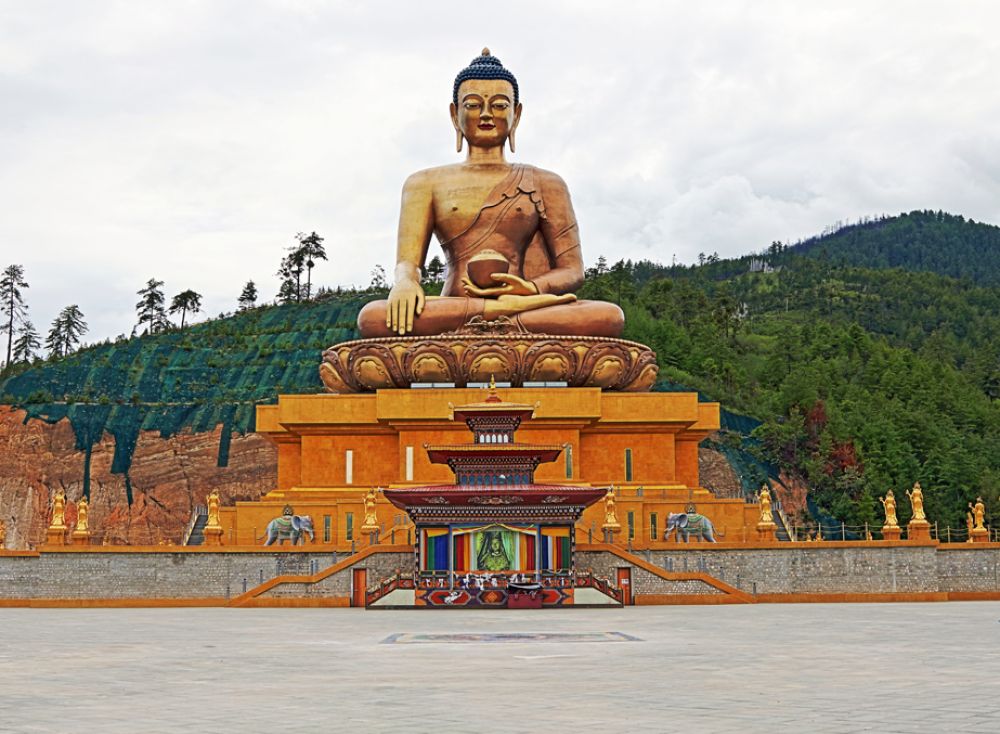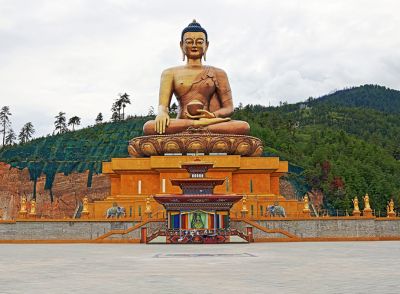

Explore the magnificent Tashichho Dzong, also known as the 'fortress of the glorious religion.' This impressive monastery and fortress serves as the seat of Bhutan's government and is located on the northern edge of Thimphu, the capital city. Visitors can marvel at the traditional Bhutanese architecture and learn about the country's history and the significance of Buddhism in its culture. The Dzong houses the throne room, offices of the king, and various government ministries. It is also the summer residence of the monastic body. The visit typically includes access to the courtyards, temples, and a view of the exquisite murals and craftsmanship. Tours are generally conducted in the late afternoon when the Dzong is open to tourists after government working hours.
Standing at 51.5 meters and overlooking the southern approach to Thimphu valley, the Buddha Dordenma Statue is one of the largest statues of the Buddha in the world. The statue contains 125,000 smaller Buddha statues placed within it. Constructed to fulfill an ancient prophecy and bring peace to the world, the statue is a popular attraction for both pilgrims and tourists. The site provides panoramic views of the valley, making it an excellent spot for photography enthusiasts. Visitors can take a leisurely walk around the statue and the surrounding area, which includes the Kuenselphodrang Nature Park. The presence of the statue is said to emanate an aura of peace and happiness to the entire world.
Thimphu Tshechu is one of Bhutan's grandest festivals and provides a cultural experience unlike any other. Held annually in the capital, the festival is celebrated with several days of traditional Bhutanese dances, music, and religious performances. It draws thousands of locals and tourists alike, all eager to witness the masked dances that depict stories of good triumphing over evil. The festival also includes colorful displays, regional cuisine, and handicraft stalls. It's a vibrant window into the Bhutanese way of life and provides an opportunity for visitors to partake in local customs and festivities. The festival normally takes place in the autumn months, and travelers are advised to book their trips well in advance due to the popularity of the event.
Simply Bhutan is a living museum that offers a glimpse into the traditional Bhutanese lifestyle. It's an interactive space where you can learn about the country's ancient culture through exhibits, demonstrations of archery and other traditional games, folk dances, and even try traditional attire. The museum showcases typical Bhutanese houses and provides visitors with an understanding of local customs, traditions, and daily life practices. By exploring different aspects of Bhutan's heritage, including its cuisine, arts and crafts, and religious practices, visitors get a comprehensive overview of what makes the country and its people unique. Additionally, the museum exhibits efforts to preserve this way of life in the modern world.
The National Memorial Chorten is an iconic stupa located in Thimphu, erected in memory of the third Bhutanese king, His Majesty Jigme Dorji Wangchuck. Built in a traditional Tibetan style, it stands as a symbol of world peace and prosperity. The chorten is one of the most visible religious structures in Thimphu and serves as a focal point for daily worship. Local residents often circumambulate the stupa while reciting mantras and spinning prayer wheels. Inside, you can find elaborate paintings and sculptures that depict various aspects of Buddhist teachings. The site is not only a testament to the revered monarch but also a center for faith and reflection, drawing pilgrims from across the region.
This wildlife reserve, located just a short distance from the heart of Thimphu, is dedicated to the Takin, the national animal of Bhutan. An enigmatic creature that resembles a cross between a cow and a goat, Takins are native to Bhutan and are rarely found elsewhere in the world. The preserve offers an opportunity to see these animals up close, in an environment that mimics their natural habitat. Besides the Takin, visitors might also spot other local wildlife. The area is also excellent for nature walks and provides a refreshing escape from the city. The preserve is founded on the principles of conservation and education, highlighting Bhutan's commitment to environmental protection and sustainability.
The Thimphu Weekend Market is a vibrant and bustling affair that takes place every Friday, Saturday, and Sunday on the banks of the Wang Chhu River. It's a place where locals come to buy and sell a wide variety of goods, including fresh produce, meats, spices, textiles, and handicrafts. As a visitor, the market offers a feast for the senses and is a perfect venue to immerse oneself in the local culture. You can sample traditional Bhutanese foods, observe local life, and perhaps pick up some unique souvenirs. The weekend market also has an adjacent handicraft market where artisans from across the country sell their handmade products, including intricate textiles, thangka paintings, and carved wooden items.
The Thimphu Institute of Zorig Chusum, also known as the School of Traditional Arts, provides education to students in the age-old arts of Bhutan. Visitors can tour the school to witness young Bhutanese artisans being trained in various traditional crafts such as painting, wood carving, embroidery, and sculpture. The institute plays a crucial role in preserving and promoting the rich cultural heritage of Bhutan. During the guided visit, you can see firsthand the dedication and skill that goes into creating beautiful Bhutanese art. You may also have the chance to interact with the students and instructors, and there is typically a small shop on-site where you can purchase items crafted by the students themselves.
The Textile Museum in Thimphu offers visitors a deep dive into Bhutan's rich weaving traditions, which are considered an art form and a significant part of the nation's cultural heritage. The museum displays a variety of Bhutanese textiles, showcasing different weaving techniques, patterns, and the vibrant colors typically used in their creation. It also explains the role of textiles in religious, official, and everyday life. Live demonstrations by skilled weavers can often be seen, providing insight into the intricate process of textile making. The museum includes exhibits on traditional garments and the royal collection, giving visitors a glimpse into the importance of textiles in Bhutanese society.
Located on a ridge above central Thimphu, Changangkha Lhakhang is one of the oldest temples in the valley, dating back to the 12th century. The temple is a revered site for parents to receive blessings for their newborns or to have their children named. The interior holds beautiful statues and intricate paintings illustrating Buddhist teachings. From the courtyard, visitors enjoy stunning views of the Thimphu valley. The temple's tranquil atmosphere offers a quiet retreat, perfect for reflection or meditation. It is frequented by devotees and is an exemplar of the living spiritual tradition in Bhutan as well as its unique architectural style. The experience is an intimate look at the spiritual practices that are deeply rooted in Bhutanese culture.
